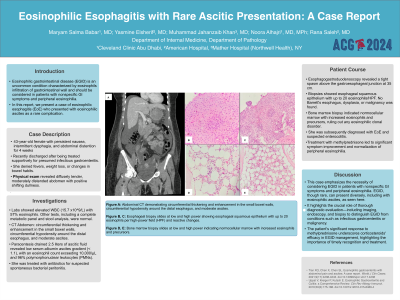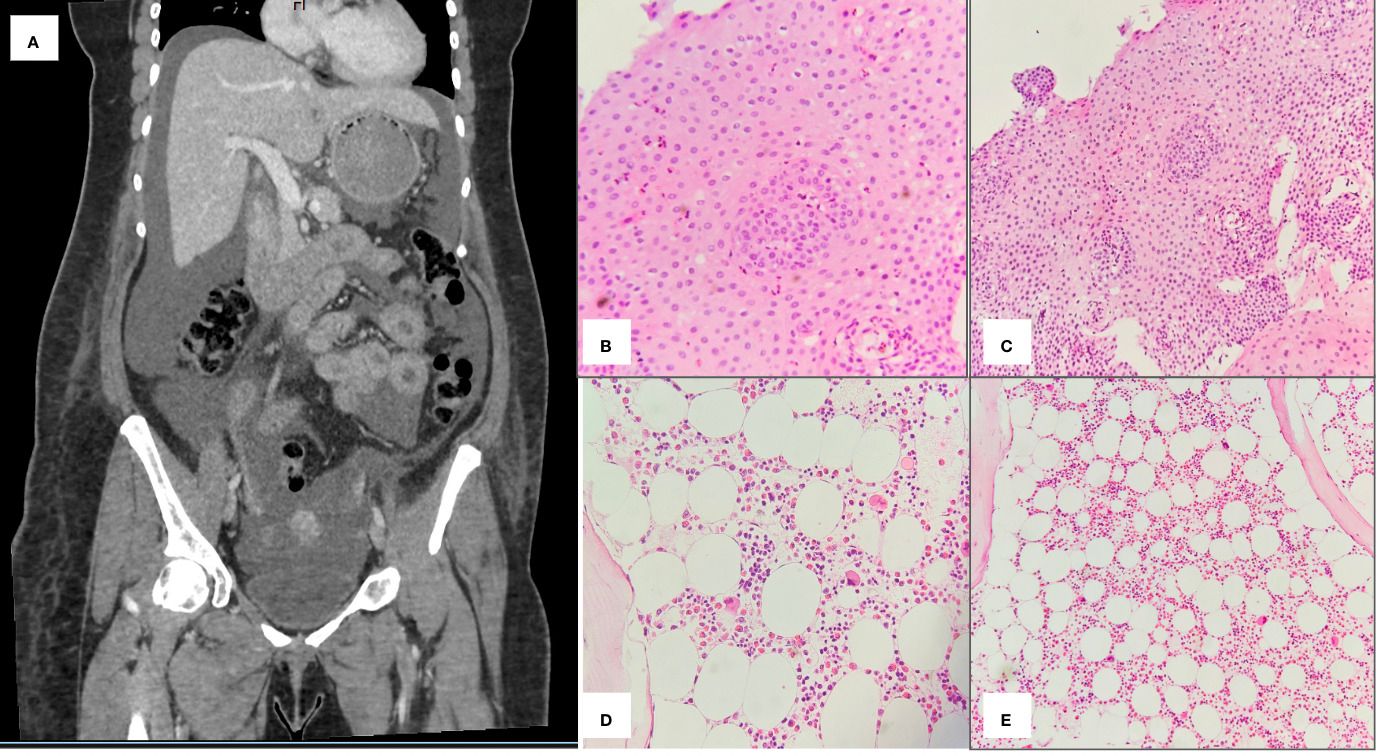Tuesday Poster Session
Category: Esophagus
P4011 - Eosinophilic Esophagitis With Rare Ascitic Presentation: A Case Report
Tuesday, October 29, 2024
10:30 AM - 4:00 PM ET
Location: Exhibit Hall E


Muhammad Jahanzaib Khan, MD
Mather Hospital, Northwell Health
New York, NY
Presenting Author(s)
Maryam Salma. Babar, MD1, Yasmine Elsherif, MD2, Noora Alhajri, MD, MPh1, Muhammad Jahanzaib Khan, MD3, Rana Saleh, MD4
1Cleveland Clinic, Abu Dhabi, Abu Dhabi, United Arab Emirates; 2Mohammed Bin Rashid University of Medicine and Health Sciences, Abu Dhabi, Abu Dhabi, United Arab Emirates; 3Mather Hospital, Northwell Health, New York, NY; 4Mohammed Bin Rashid University of Medicine and Health Sciences, Dubai, Dubai, United Arab Emirates
Introduction: Eosinophilic gastrointestinal disease (EGID) is an uncommon condition characterized by eosinophils infiltration of gastrointestinal wall and should be considered in patients with nonspecific GI symptoms and peripheral eosinophilia. In this report, we present a case of eosinophilic esophagitis (EoE) who presented with eosinophilic ascites as a rare complication.
Case Description/Methods: A 43-year-old female presented with persistent nausea, intermittent dysphagia, and abdominal distention for duration of four weeks. She was recently discharged after being treated supportively for presumed infectious gastroenteritis. She denied fevers, weight loss, or changes in bowel habits. A physical exam revealed diffusely tender, moderately distended abdomen with positive shifting dullness. Labs showed elevated WBC (15.7 x10^9/L) with 57% eosinophils. Other tests, including a complete metabolic panel and stool analysis, were normal. Abdominal CT revealed circumferential thickening and enhancement in the small bowel walls, circumferential hypodensity around the distal esophagus, and moderate ascites. Paracentesis drained 2.5 liters of ascitic fluid revealed low serum-albumin ascites gradient (< 1.1), with an eosinophil count exceeding 10,000/µL and 96% polymorphonuclear leukocytes (PMNs). She was treated with antibiotics for suspected spontaneous bacterial peritonitis. An esophagogastroduodenoscopy revealed a tight spasm above the gastroesophageal junction at 35 cm. Biopsies showed esophageal squamous epithelium with up to 20 eosinophils/HPF. No Barrett's esophagus, dysplasia, or malignancy was found. Bone marrow biopsy indicated normocellular marrow with increased eosinophils and precursors, ruling out any eosinophilic clonal disorder. She was subsequently diagnosed with EoE and suspected enterocolitis. Treatment with methylprednisone led to significant symptom improvement and normalization of peripheral eosinophilia.
Discussion: This case emphasizes the necessity of considering EGID in patients with nonspecific GI symptoms and peripheral eosinophilia. EGID, though rare, can present diversely, including with eosinophilic ascites, as seen here. It highlights the crucial role of thorough diagnostic evaluation—including imaging, endoscopy, and biopsy to distinguish EGID from conditions such as infectious gastroenteritis or malignancy. The patient's significant response to methylprednisone underscores corticosteroids' efficacy in EGID management, highlighting the importance of timely recognition and treatment.

Disclosures:
Maryam Salma. Babar, MD1, Yasmine Elsherif, MD2, Noora Alhajri, MD, MPh1, Muhammad Jahanzaib Khan, MD3, Rana Saleh, MD4. P4011 - Eosinophilic Esophagitis With Rare Ascitic Presentation: A Case Report, ACG 2024 Annual Scientific Meeting Abstracts. Philadelphia, PA: American College of Gastroenterology.
1Cleveland Clinic, Abu Dhabi, Abu Dhabi, United Arab Emirates; 2Mohammed Bin Rashid University of Medicine and Health Sciences, Abu Dhabi, Abu Dhabi, United Arab Emirates; 3Mather Hospital, Northwell Health, New York, NY; 4Mohammed Bin Rashid University of Medicine and Health Sciences, Dubai, Dubai, United Arab Emirates
Introduction: Eosinophilic gastrointestinal disease (EGID) is an uncommon condition characterized by eosinophils infiltration of gastrointestinal wall and should be considered in patients with nonspecific GI symptoms and peripheral eosinophilia. In this report, we present a case of eosinophilic esophagitis (EoE) who presented with eosinophilic ascites as a rare complication.
Case Description/Methods: A 43-year-old female presented with persistent nausea, intermittent dysphagia, and abdominal distention for duration of four weeks. She was recently discharged after being treated supportively for presumed infectious gastroenteritis. She denied fevers, weight loss, or changes in bowel habits. A physical exam revealed diffusely tender, moderately distended abdomen with positive shifting dullness. Labs showed elevated WBC (15.7 x10^9/L) with 57% eosinophils. Other tests, including a complete metabolic panel and stool analysis, were normal. Abdominal CT revealed circumferential thickening and enhancement in the small bowel walls, circumferential hypodensity around the distal esophagus, and moderate ascites. Paracentesis drained 2.5 liters of ascitic fluid revealed low serum-albumin ascites gradient (< 1.1), with an eosinophil count exceeding 10,000/µL and 96% polymorphonuclear leukocytes (PMNs). She was treated with antibiotics for suspected spontaneous bacterial peritonitis. An esophagogastroduodenoscopy revealed a tight spasm above the gastroesophageal junction at 35 cm. Biopsies showed esophageal squamous epithelium with up to 20 eosinophils/HPF. No Barrett's esophagus, dysplasia, or malignancy was found. Bone marrow biopsy indicated normocellular marrow with increased eosinophils and precursors, ruling out any eosinophilic clonal disorder. She was subsequently diagnosed with EoE and suspected enterocolitis. Treatment with methylprednisone led to significant symptom improvement and normalization of peripheral eosinophilia.
Discussion: This case emphasizes the necessity of considering EGID in patients with nonspecific GI symptoms and peripheral eosinophilia. EGID, though rare, can present diversely, including with eosinophilic ascites, as seen here. It highlights the crucial role of thorough diagnostic evaluation—including imaging, endoscopy, and biopsy to distinguish EGID from conditions such as infectious gastroenteritis or malignancy. The patient's significant response to methylprednisone underscores corticosteroids' efficacy in EGID management, highlighting the importance of timely recognition and treatment.

Figure: Figure A: Abdominal CT demonstrating circumferential thickening and enhancement in the small bowel walls, circumferential hypodensity around the distal esophagus, and moderate ascites.
Figure B and C: Esophageal biopsy slides at low and high power showing esophageal squamous epithelium with up to 20 eosinophils per high-power field (HPF) and reactive changes.
Figure D and E: Bone marrow biopsy slides at low and high power indicating normocellular marrow with increased eosinophils and precursors.
Figure B and C: Esophageal biopsy slides at low and high power showing esophageal squamous epithelium with up to 20 eosinophils per high-power field (HPF) and reactive changes.
Figure D and E: Bone marrow biopsy slides at low and high power indicating normocellular marrow with increased eosinophils and precursors.
Disclosures:
Maryam Babar indicated no relevant financial relationships.
Yasmine Elsherif indicated no relevant financial relationships.
Noora Alhajri indicated no relevant financial relationships.
Muhammad Jahanzaib Khan indicated no relevant financial relationships.
Rana Saleh indicated no relevant financial relationships.
Maryam Salma. Babar, MD1, Yasmine Elsherif, MD2, Noora Alhajri, MD, MPh1, Muhammad Jahanzaib Khan, MD3, Rana Saleh, MD4. P4011 - Eosinophilic Esophagitis With Rare Ascitic Presentation: A Case Report, ACG 2024 Annual Scientific Meeting Abstracts. Philadelphia, PA: American College of Gastroenterology.
